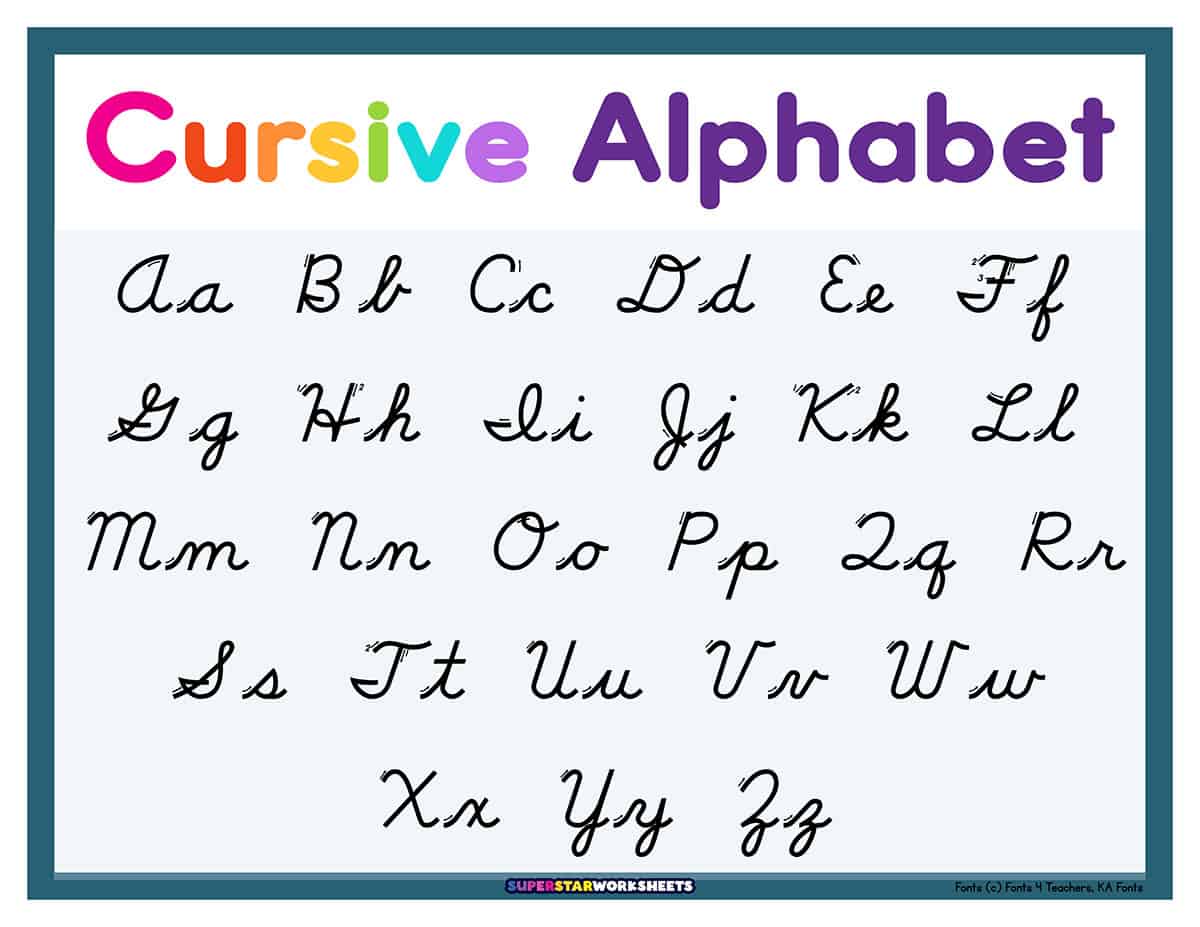Table of Contents
Introduction
Have you ever marveled at the elegance of cursive writing? There’s something undeniably charming about the flow and grace of the cursive alphabet. In a world dominated by digital communication, the art of cursive writing still holds a special place. Let’s dive into the fascinating world of cursive and explore why it’s worth mastering this beautiful script.
History of Cursive Writing
Origins of Cursive
The origins of cursive writing date back to ancient civilizations. Early forms of cursive appeared in ancient Roman and Greek scripts. The need for faster writing methods for administrative tasks led to the development of cursive, where letters were connected for efficiency.
Evolution Over the Centuries
Cursive writing evolved significantly over the centuries, with each culture and era adding its unique touch. From the medieval scribes’ intricate calligraphy to the more straightforward business scripts of the Renaissance, cursive has continually adapted to meet the needs of its users.
Modern-Day Relevance
Despite the rise of digital communication, cursive writing remains relevant. Many people appreciate it for its aesthetic value, and it’s often used in formal documents, wedding invitations, and artistic endeavors. Moreover, learning cursive has cognitive benefits that extend beyond writing.
Benefits of Learning Cursive Alphabet
Cognitive Development
Learning the cursive alphabet can enhance cognitive development. It engages different parts of the brain than typing does, promoting fine motor skills and hand-eye coordination. This brain exercise can be particularly beneficial for children as they develop their writing abilities.
Improved Handwriting Skills
Practicing cursive can improve overall handwriting skills. The flowing nature of cursive writing encourages a smoother, more controlled pen movement, which can translate to neater and more legible handwriting in both cursive and print.
Enhanced Creativity
There’s a creative aspect to cursive writing that typing simply can’t replicate. The ability to add flourishes and personalize your writing style allows for artistic expression. Many find that writing in cursive sparks their creativity in ways that typing doesn’t.
The Anatomy of Cursive Letters
Understanding Letter Formation
To master the cursive alphabet, it’s essential to understand letter formation. Each letter has a specific starting and ending point, with smooth, continuous strokes connecting them. Practice is key to getting these formations right.
Uppercase vs. Lowercase Letters
Uppercase cursive letters tend to be more elaborate than their lowercase counterparts. They often involve additional loops and flourishes. Lowercase letters are typically simpler and designed to connect seamlessly with the letters before and after them.
Connecting Letters Seamlessly
One of the hallmarks of cursive writing is the seamless connection between letters. This continuous flow is achieved through consistent practice and understanding the natural movement of the pen.
Tools for Practicing Cursive Writing
Pens and Pencils
Choosing the right tools can make a big difference in your cursive writing journey. Many prefer fountain pens or gel pens for their smooth ink flow, but even a good quality pencil can work well for practice.
Practice Workbooks
Workbooks designed for cursive writing practice can be incredibly helpful. They often provide step-by-step instructions, lined pages to guide letter size and spacing, and plenty of practice exercises.
Digital Resources and Apps
In today’s digital age, there are also numerous apps and online resources available for practicing cursive writing. These can be particularly useful for visual learners and those who prefer guided practice.
Basic Cursive Alphabet
A to Z Uppercase Letters
Mastering the uppercase cursive alphabet is a great starting point. Each letter has its unique formation, but many follow similar patterns. For example, letters like A, C, and E share common strokes.
a to z Lowercase Letters
Lowercase letters are the building blocks of cursive writing. They are typically less ornate than uppercase letters and are designed to connect easily. Practicing these will help you gain the fluidity needed for writing in cursive.
Advanced Cursive Techniques
Flourishes and Embellishments
Once you’re comfortable with the basics, you can start adding flourishes and embellishments to your cursive writing. These can add a personal touch and make your writing stand out.
Joining Difficult Letter Combinations
Some letter combinations can be tricky to connect smoothly. Practice makes perfect, so spend extra time on these challenging pairs to ensure your writing flows seamlessly.
Speed and Legibility
As you become more proficient, you’ll want to focus on increasing your writing speed without sacrificing legibility. This balance is crucial for effective cursive writing.
Teaching Cursive to Children
Age-Appropriate Techniques
Teaching cursive to children can be a rewarding experience. Start with age-appropriate techniques that make learning fun and engaging. Simple exercises and plenty of encouragement go a long way.
Fun and Engaging Activities
Incorporate fun activities like writing games, tracing exercises, and creative projects to keep children interested in learning cursive. The goal is to make practice enjoyable.
Overcoming Common Challenges
Children may face challenges like reversing letters or inconsistent spacing. Patience and positive reinforcement are key to helping them overcome these hurdles.
Common Mistakes and How to Avoid Them
Incorrect Letter Formation
One common mistake is incorrect letter formation. Make sure to practice each letter carefully, paying attention to the starting and ending points of each stroke.
Uneven Spacing and Size
Maintaining consistent spacing and letter size can be challenging. Use lined paper and practice maintaining even spacing between letters and words.
Breaking Connections Between Letters
Another common issue is breaking connections between letters. Focus on the fluid movement of your pen and practice writing words without lifting your pen.
Cursive Alphabet for Left-Handed Writers
Adjusting Techniques for Comfort
Left-handed writers may need to adjust their techniques for comfort. This can include angling the paper differently or using specific writing tools designed for left-handed individuals.
Special Tools for Left-Handed Writers
There are special pens and workbooks designed for left-handed writers. These can make the learning process more comfortable and effective.
Incorporating Cursive into Daily Life
Writing Letters and Cards
Using cursive writing for personal letters and greeting cards adds a special touch. It’s a simple way to incorporate cursive into your daily life 5 Movierulz.
Journaling in Cursive
Journaling in cursive can be a relaxing and creative practice. It allows you to express your thoughts more fluidly and adds a personal touch to your journal entries.
Cursive in Art and Design
Cursive writing can also be used in art and design. Many artists incorporate cursive into their work, whether it’s through calligraphy or other creative projects.
Cursive Writing in the Digital Age
Digital Fonts and Calligraphy
Digital technology offers numerous ways to incorporate cursive writing. There are many digital fonts and calligraphy tools that mimic the beauty of cursive.
Online Platforms for Practice
Online platforms offer guided practice for cursive writing. These resources can be particularly helpful for those looking to improve their skills.
Balancing Typing and Handwriting
While digital communication is prevalent, balancing typing and handwriting is important. Both skills have their place, and cursive writing adds a personal touch that typing can’t replicate.
Cursive Alphabet in Different Languages
Differences in Letter Formation
Different languages can have unique cursive letter formations. Exploring these differences can broaden your understanding and appreciation of cursive writing.
Unique Characters and Symbols
Some languages have unique characters and symbols that add to the complexity of their cursive alphabet. Learning these can be an exciting challenge.
Resources for Multilingual Writers
There are numerous resources available for multilingual writers looking to practice cursive in different languages. These can provide valuable guidance and practice exercises.
Maintaining and Improving Cursive Skills
Regular Practice Routines
Maintaining your cursive skills requires regular practice. Set aside time each day to practice writing in cursive, whether it’s through journaling, writing letters, or other activities.
Advanced Workbooks and Guides
For those looking to take their cursive writing to the next level, advanced workbooks and guides offer more challenging exercises and techniques.
Joining Cursive Writing Communities
Joining cursive writing communities can provide motivation and support. These communities often share tips, resources, and encouragement to help you improve your skills.
Conclusion
The cursive alphabet is a timeless art that combines beauty and functionality. Whether you’re just starting or looking to refine your skills, the journey of mastering cursive writing is both rewarding and enriching. Embrace the charm of the cursive alphabet and enjoy the creative expression it offers.
FAQs
What is the best age to start learning cursive?
Children can start learning cursive as early as 6-7 years old, depending on their fine motor skills and interest.
How long does it take to master the cursive alphabet?
The time it takes to master the cursive alphabet varies, but with regular practice, most people can become proficient within a few months.
Can left-handed people write in cursive?
Yes, left-handed people can write in cursive. They may need to adjust their techniques and use special tools for comfort.
Is cursive writing still taught in schools?
Cursive writing is still taught in some schools, although its prevalence has decreased with the rise of digital communication.
What are the best resources for learning cursive?
There are many resources available for learning cursive, including practice workbooks, online platforms, and digital apps designed to guide and improve your skills.


